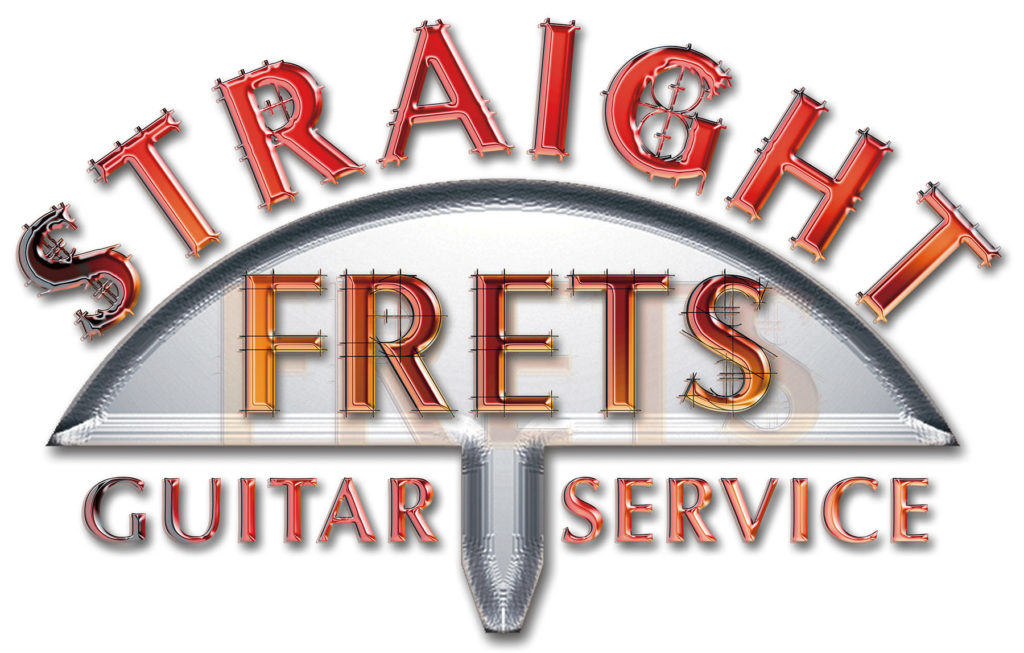Tips for Players
Tip #1
Basic maintenance goes a long way. Keep your strings fresh, your frets polished, and your fretboard cleaned and conditioned. If you can run your finger underneath an unwound string and it collects dirt, that’s what cuts into your frets. If you run your finger underneath a wound string and it has divots where the frets are, you can’t expect true intonation. If you have a rosewood or ebony board (not a maple or even this new baked maple that Gibson is putting out), you can keep your frets polished with a small piece of 0000 steel wool. Better yet, what we use here are 4-way padded nail buffers made by Tropical Shine, sold at Sally’s Beauty Supply. Only the final 2 stages have to be lightly slid over the tops of the frets during a string change to retain the shine of a Straight Frets setup. I suggest using Orange Glo to clean/oil the board. You can find it at Lowes, Home Depot, or some grocery stores. I fold a paper towel three times, squirt a few pumps on one half, then proceed to clean the board while immediately following with the dry half. This way the board doesn’t get drenched and is more likely to not swell. Orange Glo has a pleasant citrus scent and leaves the board slightly oiled.
Tip #2
Use a paper towel for cleaning, polishing, and buffing everything. There is a TON of research and development that goes into the science of a paper towel. I learned this trick from a boutique guitar store I worked at for several years in Atlanta: a paper towel will never scratch, they are cheap, made to be thrown away after one use, and will create the same polished result as a Terry cloth towel, which will pick up debris and scratch a surface after one use.
Tip #3
Try a 9.5’s or 10.5’s instead. Are you one of those electric players who jump from 10’s to 11’s all the time and can’t really settle on what string gauge to use? Try a pack of 10.5’s. They are right in between the two and we stock them with D’addario, GHS, and Ernie Ball, now with their Earthwood 11.5’s and 12.5’s for acoustic steel string guitars.
Tip #4
If you’re a classical player but experience an incredibly sharp G, which is common to most tradition nylon strings, try a Savarez high tension Alliance 3rd string (543J) or use a D’addario half pack of trebles using their own carbon technology. It balances out the tension between the others and makes for a smoother tonal transition from the nylon trebles to the wound bass strings. I love D’addario strings for their value, consistency, and quality, but I always change the G from a J46 High Tension pack to the high tension Savarez Alliance G. Being that this 3rd string isn’t as elastic, it is less sharp of a string.
Tip #5
Tighten your tuners a few times a year. A 10mm nut driver or a crescent wrench will do it. It’s easy to over do it, so gingerly tighten them down. This is something that can help stabilize your tuning and reduce unwanted sympathetic vibrations if they are extremely loose.
Tip #6
Don’t use lubricant, jell, or graphite pencil in your nut slots, unless you plan on cleaning it out and replacing it fresh with every string change. If you have a quality bone nut that is cut properly, the bottom of the slot should be a smooth surface that almost looks waxed under magnification. Any other lubricant attracts dirt and grime, which leads to the string binding in the slot, and, in time, starts to cut the nut slot deeper. If your string suddenly jumps up in pitch after turning the tuner with no result at first, you could either have a nut slot that’s binding the string, or the nut slot could possibly be not tapering away from the string where it exits the slot. Either way, if you have issues with that, Straight Frets is here to help you get positive results with your guitar.
